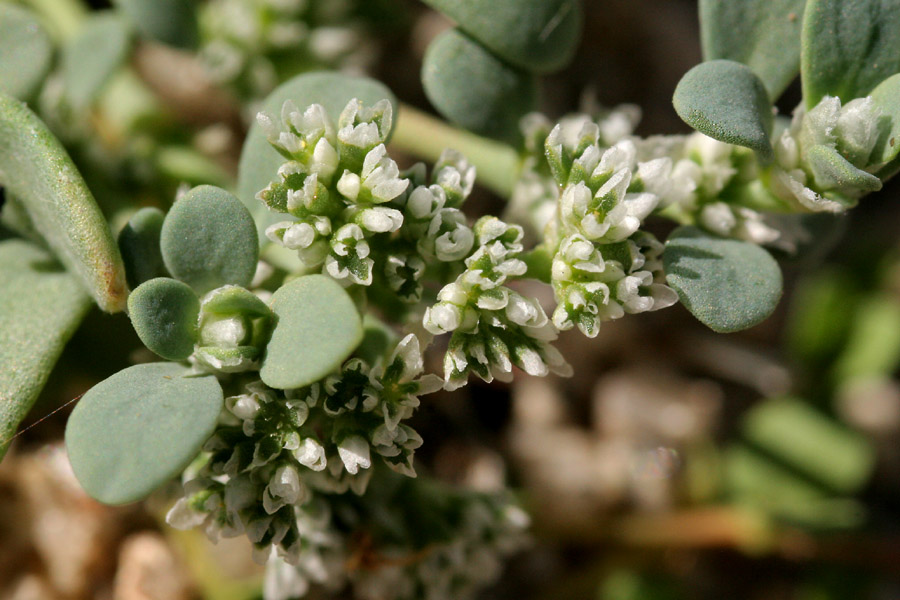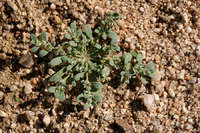|
|
|
|
Family: Caryophyllaceae
onyxflower
|
Stems 3-17 cm, mostly glabrous. Leaves pairs unequal; stipules 0.1-0.4 mm; blade 3-20 mm. Inflores-cences 20-60+-flowered. Flow-ers: perianth 2.5-3 mm; hypanth-ium green, becoming brown and hard, 10-ribbed distally; sepals erect to spreading, concave, cen-tral portion green, fleshy, white, scarious portion forming an ovate to orbiculate apex, 1-1.3+ mm wide, becoming deciduous with age; staminodes ca. 0.5 mm. Seeds 0.9-1.1 mm. Flowering spring. Dry, sandy areas, sand dunes, desert washes; 50-700 m; Ariz., Calif.; Mexico. FNA 2005, Jepson 2012, Kearney and Peebles 1969 Duration: Annual Nativity: Native Lifeform: Forb/Herb General: Herbaceous annuals, to 17 cm tall, stems numerous, mat-forming and prostrate to ascending and branching, rounded to angular, bluish-green and glabrous (smooth and hairless), plants with slender taproots. Leaves: Opposite in unequal pairs, succulent, spatulate, 3-20 mm long, obscurely 1-veined, with entire margins, blades connate or connected by a thickened ridge or transverse wing from which conspicuous stipules arise, the stipules 2 per node, white, ovate to spatulate, to 0.5 mm long, with fringed to ciliate margins and entire apices. Flowers: Sessile, greenish-white, petals absent, sepals and perianth making up the flowers, sepals 5, distinct, herbaceous and green with white margins and jagged, thin, white, membraneous (scarious) tips, broadly ovate to orbiculate or reniform, 1.2-1.5 mm long, concave, erect to spreading, with broadly rounded apices, scarious portions forming an ovate to orbiculate apex, 1-1.3 mm wide, this deciduous with age, perianth 2.5-3 mm long, stamens 1-4, filaments distinct to base, nectaries at filament bases subtended adaxially by flaps of tissue, staminodes filiform, 14-19, about 0.5 mm long, arising from hypanthium rim, styles 2, filiform, glabrous and connate in proximal half, 0.2-0.4 mm long, stigmas 2, linear along adaxial surface of styles, hypanthium green and becoming brown and hard with age, cylindric to urceolate, 10-ribbed distally, abruptly expanded proximally and distally in fruit, infloresences with paired subtending bracts that resemble the stipules, flowers in groups of 20-60 or more, borne in dense clusters at branch tips and in leaf and branch axils throughout the length of the stem. Fruits: Obconic to ovoid modified utricles with 8-10 minute teeth, not spreading. Seeds to 1 mm long, tan with a red spot near one end, ovoid and slightly laterally compressed with smooth surfaces. Ecology: Found in dry, sandy areas, sand dunes, and desert washes, from 150-2,500 ft (45-762 m); flowering in spring. Distribution: Arizona, California; Mexico. Ethnobotany: Unknown. Synonyms: Corrigiola litoralis Editor: LCrumbacher2012 Etymology: Achyronychia comes from the Greek for "chaff claw" or "fingernail" alluding to the chaffy calyx, and cooperi is named after Dr. James Graham Cooper (1830-1902), geologist of the Geological Survey of California, who collected plants in the Mojave Desert in 1861. |



